- Think Carefully About Planning Content For Your eCommerce Website
- Previous Considerations For Your eCommerce Content Plan
- Conclusion
However, you don’t have to worry anymore; the same will not happen to you because today, I will teach you how to create content for eCommerce website so that your business prospers.
Are you ready to start this journey?
Think Carefully About Planning Content For Your eCommerce Website
When starting your eCommerce, defining who will be in charge of planning the content and writing it is essential. This way, the work will be done in an organized and efficient manner. How you carry out a content plan that promotes your services through content is essential for your customers.
Therefore, you must define a goal for each content. You need to stop and think about what you want to achieve with each piece of content writing for eCommerce website created.

Also, you should not generate content to write anything. Please consider functions such as attracting traffic to your eCommerce website, getting a lead where they leave their contact information, clearing doubts about your products or services, converting a prospect into a client, etc.
In addition, you have to choose the tone of communication that best suits your brand’s personality. Try to make sure that the communication and style of your content are consistent with the brand strategy you have previously defined.
Your eCommerce content plan can help you move ahead of your competitors
Once you finish your content plan, it will be much easier for you to achieve a good content marketing strategy because the content plan comprises the entire content structure and the form of content that presents your eCommerce website.
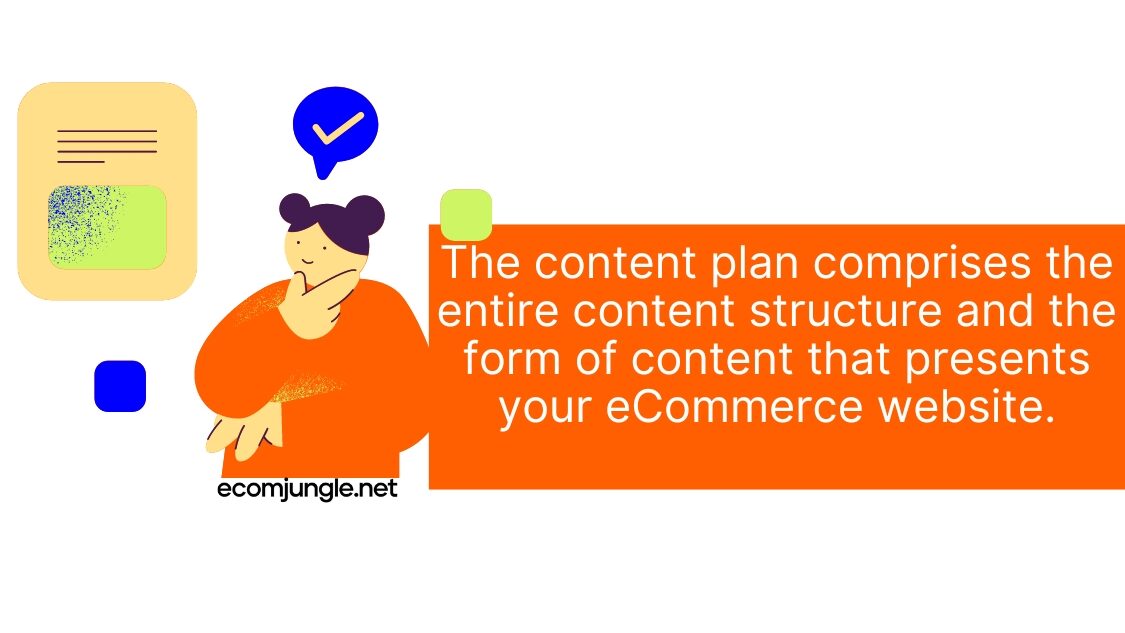
Thus, optimizing your eCommerce with SEO-friendly content and keyword research or initiating advertising campaigns will be much more efficient, allowing you to get ahead of many of your competitors.
Previous Considerations For Your eCommerce Content Plan
Some elements that you may have already considered when preparing your Marketing Plan and keyword research may be helpful to put you in the right situation. They will also help you to know how to plan the content you need to attract future buyers.
Likewise, the content of your plan should be focused on complying, step by step, with the following considerations:
- Create content to capture the attention of your potential customer. This way, you will be able to convert them into buyers.
- Use elements that can raise your prospect’s level of interest.
- Highlight your value proposition. It must be able to awaken your potential customer’s desire to buy what you sell.
- Build your prospect’s trust to generate credibility for your brand.
- Use clear calls to action. Convince them to become a lead.
Did you already know that?
Which pages need content in eCommerce websites
But to remain competitive in a market that has already become professionalized, it is vital to squeeze the most out of all the content we generate so that we can attract more potential customers to our eCommerce store, but above all, help them decide what products to buy, speed up the process and also get them loyal to achieve the profitability of our business.
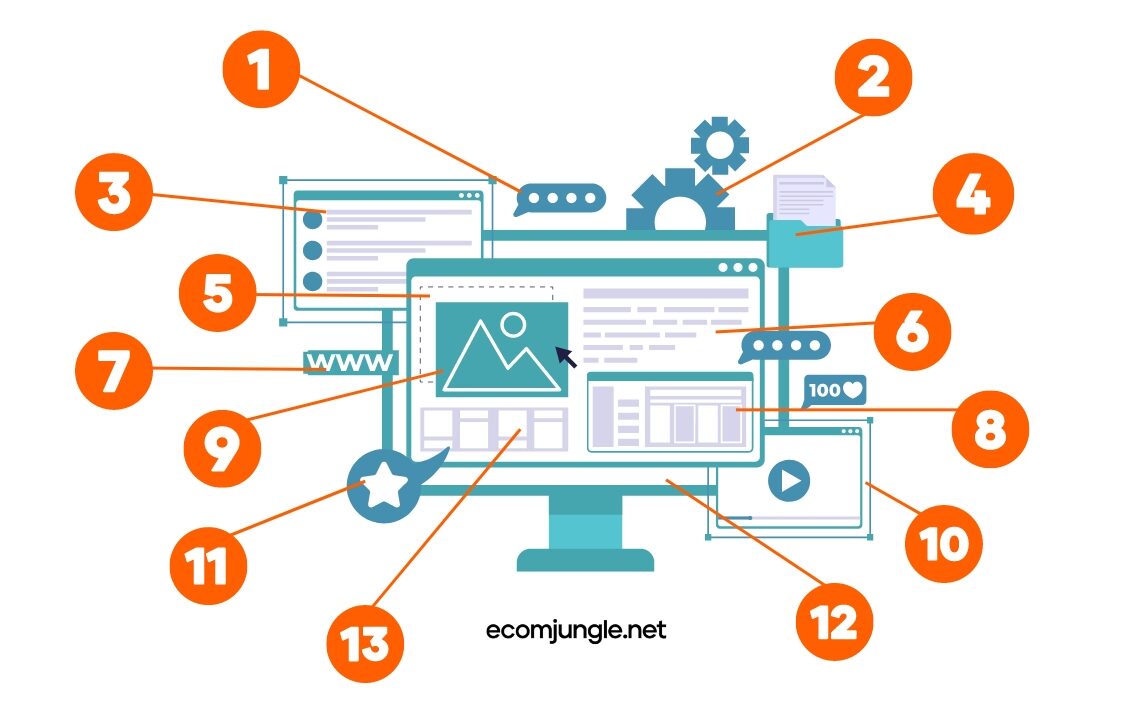
Therefore, in your content plan you have to include these pages:
- Homepage.
- Product category page.
- Product list pages.
- Product descriptions.
- Service pages.
- Shipping.
- Order confirmation.
- Returns.
- Contact page.
- About us page.
- FAQ page.
- Policy pages.
- Blog.
So let’s work with the types of content you should create!
Homepage
The home page is the essential element of the entire website and plays a fundamental role. Thus, you must create specific and explicit content for each section of the home page, such as:
- Header is the first section of the website where you will see an image or video along with a small text or call to action.
- Products or services: A list of products or services is presented with short descriptions, which will be more detailed on the store page.
- Testimonials: The power of testimonials used correctly is brutal. Think Amazon or Google My Business.
- About us: write brief content about the company, which will be developed at length on the corresponding page.
- Contact us: You should write informative content about your contact channels to encourage the reader to communicate with your company.
A home page must have around 300 – 1000 words depending on the business’ niche.
Pro Tip:
Remember that in the footer, you can put the information you have not put anywhere else. Here you can set the privacy policy and cookies used by your website, social networks, and even your physical business address.
Product Category Page
Categories are pages within your website that organize the content under a criterion. For an eCommerce content plan, the most common classifications are by product, audience, brand, or material.
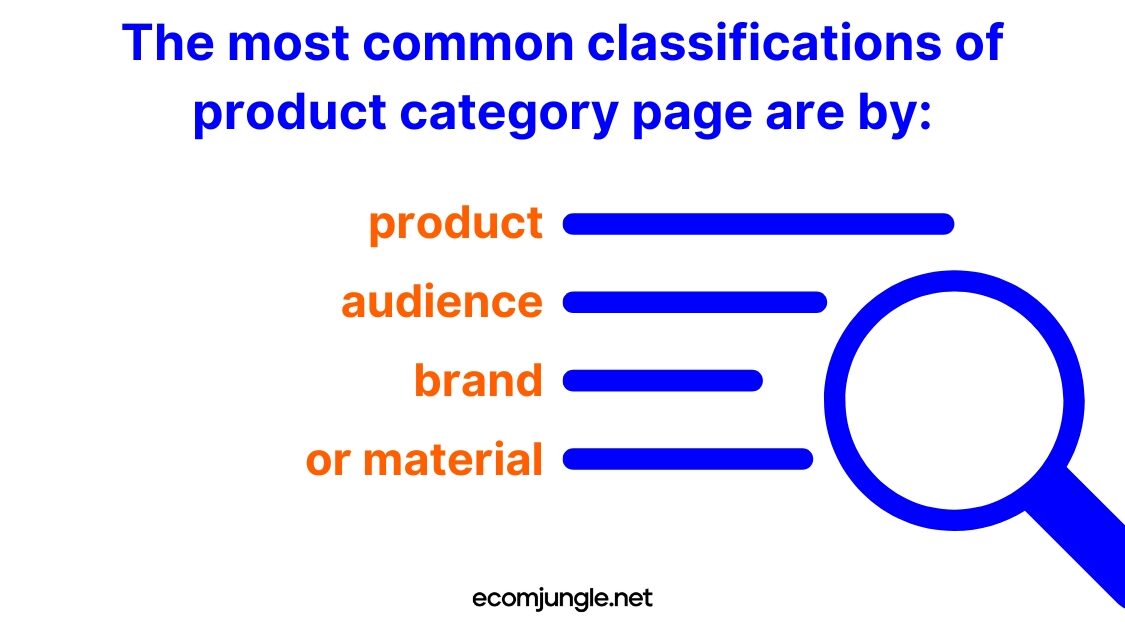
Although they are the great forgotten in the SEO of many online stores, categories have two crucial advantages:
- Your positioning strategy is much more complete: while with product cards, you can attack long tails, with categories, we position ourselves in more powerful keywords.
- You improve the architecture of your website: you help the user to find what they are looking for sooner. And if you add a product search engine, even better.
A product category page must have around 200 – 500 words.
Product list pages
Product pages are one of the most essential contents of your ecommerce business because they fulfill a double primary mission:
- To help our buyers understand what product they are going to buy and what features it has.
- To “explain” to Google everything it needs to know to position our product in its search results properly. This way, your online store will have more organic search traffic.
A product page must have around 300 – 400 words.
Product descriptions
A product description communicates to potential customers the features of a product, usually in a comprehensive, informative and concise manner. At the same time, they try to attract their attention and highlight the product’s benefits. Depending on the online store and the target audience, the product presentation should be entertaining, objective, and neutral. A product description’s ultimate goal is to encourage the customer to make a purchase and build their trust in eCommerce.
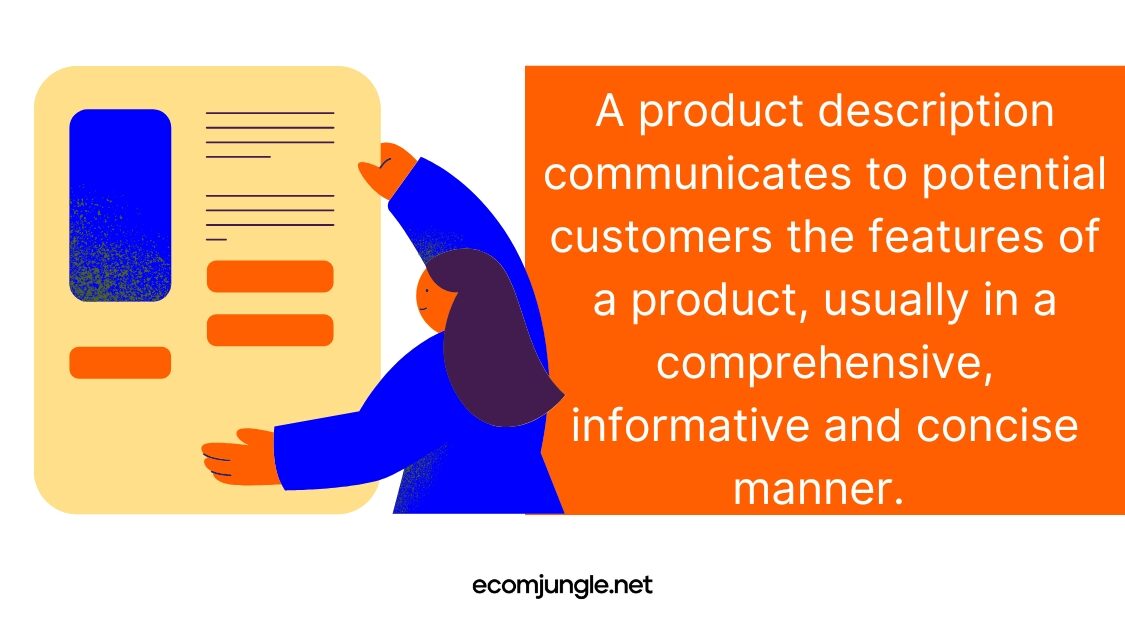
A product description must contain around 20 – 100 words and should include bullet points.
Service pages
Service pages are one of the essential pages of the web since they are the ones that will show what you have to offer to your customers.
In them, we must put all our effort and make the best we have to try to write persuasive, detailed, accurate, and quality content to convince potential customers that your services are the best.
A service page must have around 350 – 600 words.
Shipping
Having content for your shipping page that is clear and easy to understand gives potential customers the peace of mind of knowing that if there is a problem, there is a protocol in place to complete the sale correctly.

As the person in charge of an eCommerce business, it is up to you to decide what policies to offer your customers. There are some essential points that you should include in this document:
- Define the geographical scope of your shipments.
- Define the associated shipping costs.
- Establish the delivery times of your shipments.
- Determine when the time for delivery begins to elapse.
- Inform your customer about the status of the shipment.
- Create a question-and-answer section for your customers.
- Define the actions to be taken when the order is delivered.
A shipping page must have around 100 – 500 words.
Fascinating, what do you think?
Order Confirmation
After the customer makes the payment, try to send a thank you message in which you confirm that the purchase has been completed. Also, it is necessary to show the details of the purchase and information regarding returns in case there were errors after the shipment.
An order confirmation page must have around 20 – 50 words.
Returns
Having a clear and flexible return policy will allow potential customers to lose the fear of buying in your store and reduce the risk of losing money, either because of faults or simply because the product was not what they expected. Also, if you want your customers to know and value your policy, then make sure you write it for them and not for a lawyer specializing in the subject. So, it would help if you used language similar to what you use in the rest of your store.
A return page must have around 100 – 500 words.
Contact page
Your contact page has to invite users to contact you. A contact page becomes a critical space to reinforce the process the visitor who came to your eCommerce site before reaching you is going through. It is your golden moment to remind them that you can help them with their needs.
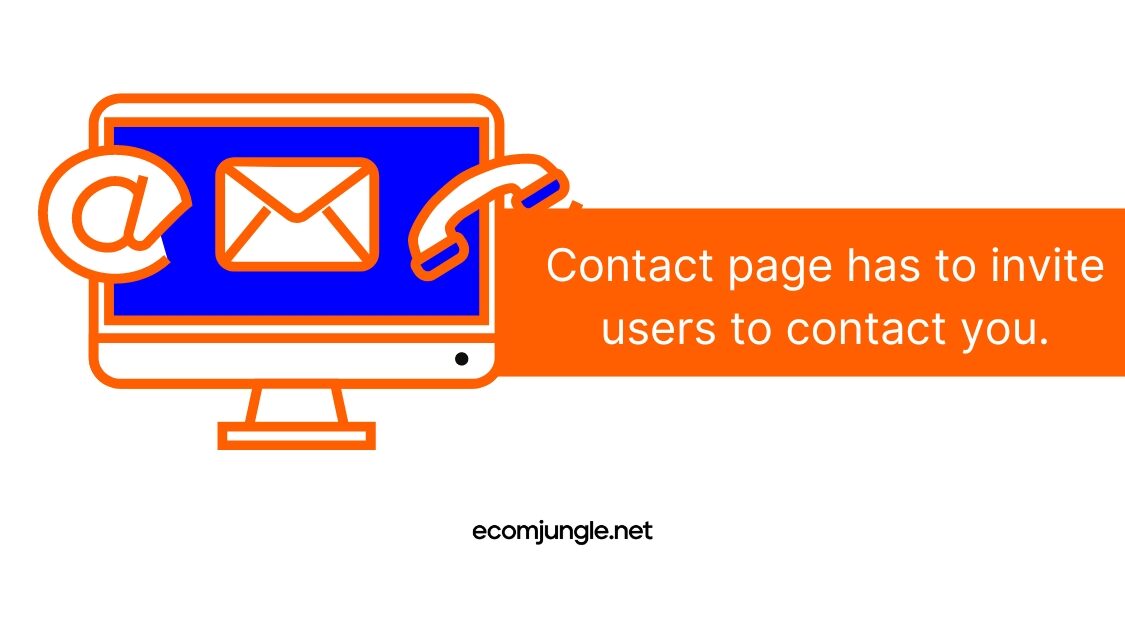
A contact page must have around 100 – 250 words.
About us page
The “About us” or “who we are” page is the section or category of a website that summarizes in a descriptive way how the business was born, who are part of the responsible team, and, above all, explains the mission, vision and values of the company on the Internet.
Having clarified this, you understand better the importance of this page within a website, especially for those who visit you and still do not know your eCommerce brand.
An about us page must have around 250 – 500 words.
FAQ page
The Frequently Asked Questions page allows you to give a quick answer to the most common questions that your potential customers may have.
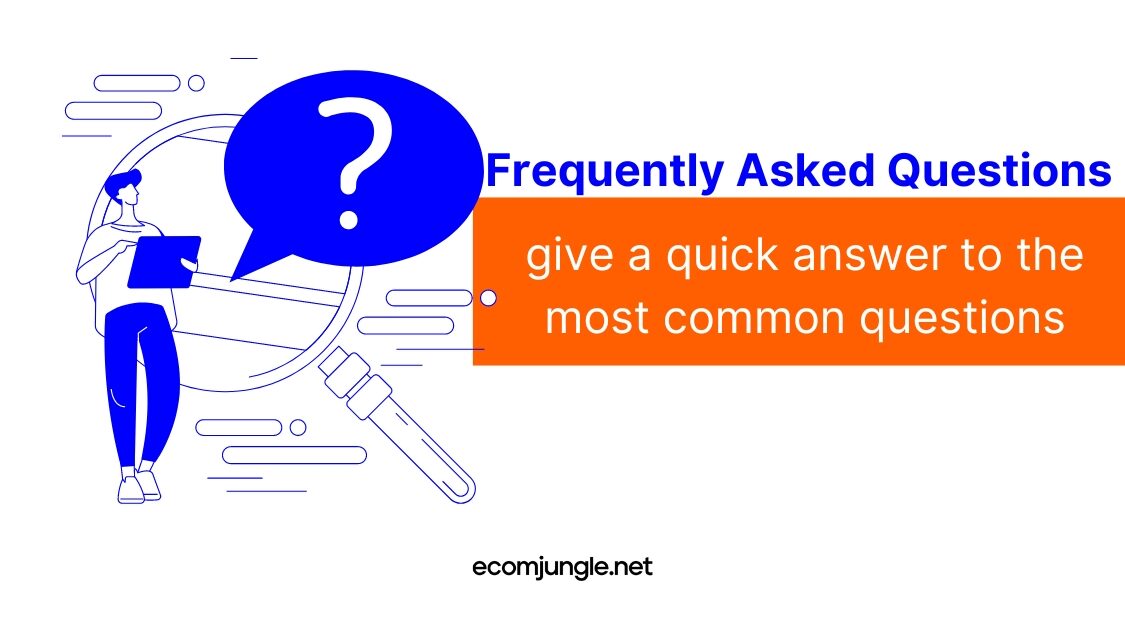
A FAQ page must have around 200 – 500 words.
Policy pages
A policy page for your eCommerce and social media marketing is an official company document that provides specific guidelines on data handling, privacy, or returns within the organization. These policies should apply to everyone and should be simple to understand.
A policy page must have at least 500 words.
Blog
Blog posts are essential in each eCommerce to increase the authority and SEO. Each blog post you write will be organized and grouped on this page, so you need to look for blog ideas to write about different topics. This content strategy helps improve your company’s exposure.
Each blog post should have at least 500 words.
What about the Size For E-commerce Product Images?
Make sure your photos are not blurry! They should be at least 640 x 640 pixels on both sides. We recommend 1200 x 1200, so they can be zoomed in. Remember that this point applies to all your photos. Keep in mind that, according to Hubspot’s statistics, promoting an ecommerce business with visual content can increase the audience.
Other Recommendations For The E-Commerce Photo Size
Image sizing is an essential input, but even including it, there are a few more vital requirements for eCommerce product images. Some of them are:
Quality
Pro lighting and lifelike color should be employed to build high-quality product photos. A vendor can use some filters to enhance the image and get it to show up as it would appear in person, but only to closely match real-life tones.
File format
TIFF, JPEG, PNG, JPG, and BMP are popular file formats, but JPG is the most frequently used.
Color
Avoid bold images on the website and product background color.
Ratio
While 1:1 square is the prevalent aspect ratio for an e-commerce product image, many sites or departments have different ratios for their products depending on their demands.
Resolution
Ecommerce web pages mostly need a 72 to 300 dpi resolution.
Final ideas to consider in your content plan
Keep in mind the last piece of advice when planning and writing your eCommerce content plan.
Commit to content creation
Content planning must be carried out with absolute responsibility, so the person in charge of this process must ensure that each phase in the content creation is fulfilled. This person must take their role seriously and know how to communicate to the entire team involved in their activities and objectives to achieve them effectively.
Manage content creation
When you start to plan content for your eCommerce website, you must establish a team to collaborate on content development. The staff needs to know your business inside out and should constantly be looking for a wealth of ideas and inspiration.
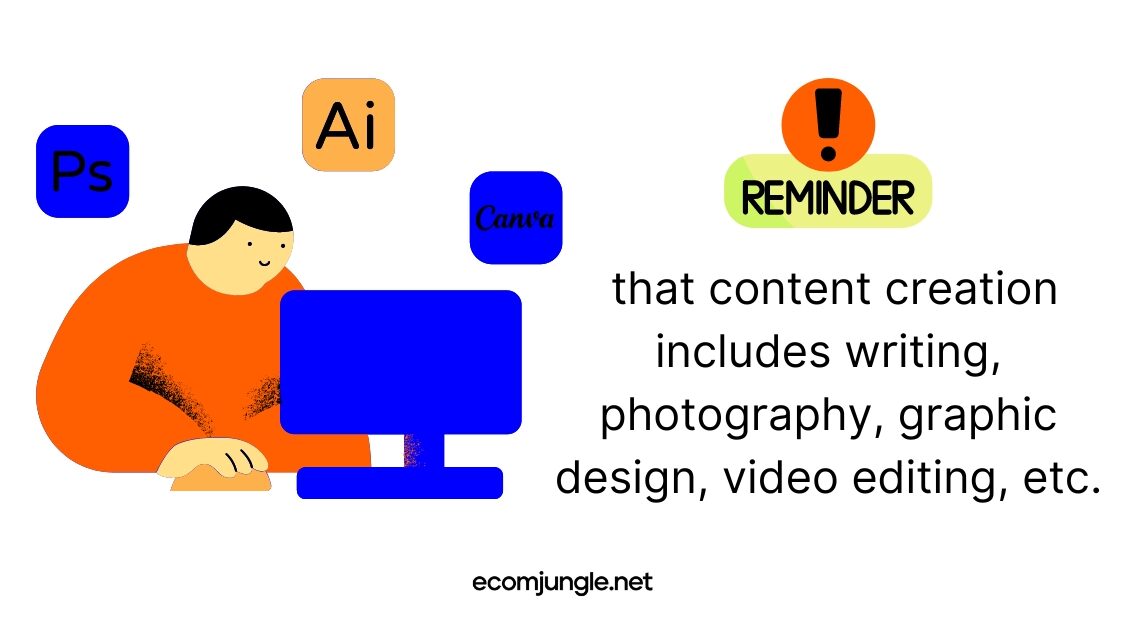
Remember that content creation includes writing, photography, graphic design, video editing, etc. So, when planning content, you must make sure you have the people who will be responsible for its production and that they have the necessary knowledge to fulfill each assignment.
In this way, you will also have to evaluate whether these contents will be produced internally or outsourced.
Pro Tip;
If you need a large amount of content, outsourcing is a better option because it saves costs and increases production capacity. This way, you only have to edit the project in-house, which is cheaper and gives you a final control over the assignment.
Translate content for your eCommerce website’s customers
In eCommerce content plan, translation plays an essential role, being the only way to break down borders and bring cultures closer, making your business accessible nationally and internationally. Remember that in eCommerce sites, there should be no barriers or boundaries.

Don’t forget to take search engines into account
One of the main objectives of companies that invest in digital marketing is to reach the top positions in search engines. Therefore, your content plan must contain the following:
- Keywords.
- Images with little weight.
- Alt text in the pictures.
- A whole series of search engine optimization techniques that you must apply recurrently in your eCommerce according to the strategy you implement so that your contents appear in the first positions of the search results.
Think about mobile version
Smartphone users are becoming more experts and performing more specific searches according to their needs. So, if we put ourselves in the shoes of the user we want to target and their mobile moment, we will realize that they are looking for specific and well-structured content.
The content structure is essential; without it, the user chaotically perceives the web and does not find the information he is looking for, which is why it favors a website at the SEO level.
Are you ready to start?
Conclusion
Ecommerce needs to be supported by all possible types of content to convince users to buy from our store and help them decide which products to buy.
Indeed many of you have already experimented with some of these types of valuable content in your online store, so now that you know what content you should take into account in your eCommerce content marketing plan and what additional aspects to consider, you can tell me what your experiences and opinions have been in the comments of the post.
Start your content writing for eCommerce website right now!